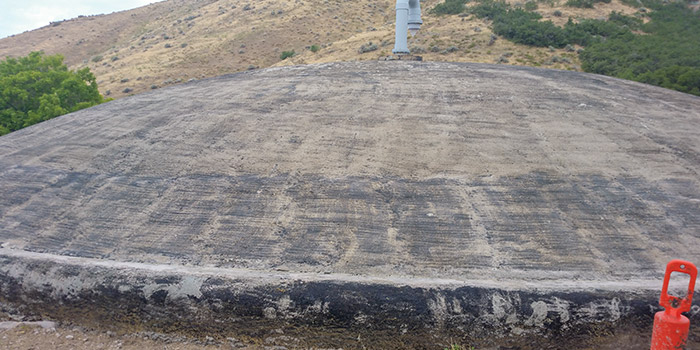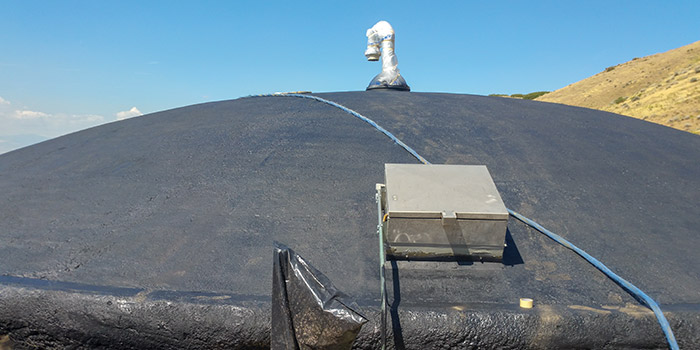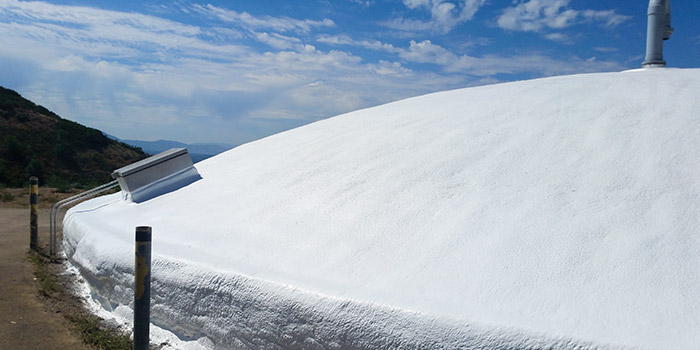
Twin Tanks

SALT LAKE CITY, UT – May 3, 2018 – Salt Lake City, Utah, the same spot within the Utah Valley of the Great Salt Lake where Brigham Young led 148 Mormon pioneers and exclaimed “This is the place,” remains a unique area to settle in. Although it has a vast metropolitan area, some folks choose to reside on its outskirts near the Wasatch and Oquirrh mountain ranges. Recently, there was a spray foam roofing system application that took place near a high-end community that was located within the mountains. But the actual project wasn’t on a roof itself, but rather on the “top” or “lid” of two water tanks. These water tanks provide the water supply for the community and they were built into the mountain so that the only part of them that was exposed to the elements was these lids.
Although the lids had been formerly protected with a different system, the coating had thinned out and showed evident signs of blistering and delamination. There was also damage to the interior of the tanks as the coating liner had also shown signs of failure. This situation simply would not do since these tanks held the water supply of the community, so the structures were in need of a complete makeover.
DN Tanks, a tank manufacturing and refurbishing company, spearheaded the interior portion of the project. Their crew went in and stripped off the liner inside the tank and reapplied it to render optimal performance. The DN Tanks team even tore off the existing system on the exterior, patched a few cracks in the concrete, and power washed the concrete substrate to clear it from all debris to provide a smooth surface for the exterior system installation. But that’s as far as DN Tanks went before Simon Foam and Coatings (SFC), a contracting company that specializes in the application of SPF roofing systems, took over.
“These exposed lids needed a system that was going to protect these tanks for a long time to come and ensure there is no heat transfer from the concrete to the water. For that these surfaces need to remain cool,” says SFC’s Project Manager Louis Bongiolatti. “It was pretty much the same concept as a roofing application.”
The lids are 70,000 board feet in size and they stand two feet off the ground on their outer perimeter and 18 feet at a maximum height at the center of their dome-like slope. Luckily, the lids were located about a city block away in distance from the housing community in a picturesque area where mountains towered around them, leaving little to no room for wind activity and overspray concerns. The SFC crew drove through the community in a zigzag motion to go up to the farthest and highest point where the road ended and where the tanks were located. They arrived at the site with a three-man crew and a rig equipped with a Graco E-30 proportioner, a Graco GH33 Big Rig hydraulic airless sprayer, a Graco Fusion air-purge spray gun, and 310 feet of heated hose.
 |  |
The first part of the system involved the application of PremiCote P75, an acrylic, water-based, premium quality jet black primer.
The SFC crew worked with products made by Accella Polyurethane Systems, who was able to provide a 20-year “No Dollar Limit” (NDL) warranty for all materials utilized during the application. This provided peace of mind to the operators that if for any reason the system did not perform to its stipulated ability, the manufacturer would cover the cost of damages and recoating altogether.
“Even though there’s no other system that can provide the type of protection, reflectivity, and insulation than this one can, having an NDL warranty to back it does offer an added benefit to the customer,” says Bongiolatti.

Two inches of spray foam were installed to each tank lid. Then the white silicone coating provides solar reflectivity to keep the lids cool and protected from any type of abrasion.
Even though the substrate of each tank lid had been power washed, the SFC crew made sure to clear any loose dust off the surface with backpack blowers. Before any materials were installed, they covered the vent tubes of the tanks with plastic sheeting to ensure no materials went inside the tanks. The first part of the system involved the application of PremiCote P75, an acrylic, water-based, premium quality jet black primer. The crew hand-rolled the primer at a gallon per-square-foot depth, which according to Bongiolatti was a greater thickness than average but one they deemed fit to ensure foam adhesion to the substrate.
For the foam application to both tops, SFC used PremiSeal 280, a nominal 2.8 pounds-per-cubic-foot density closed-cell polyurethane roofing foam that provides a superior R-value of 6.3 per inch and a continuous insulation without thermal breaks— a crucial choice for this particular project. The three SFC crewmembers started from the bottom of the tank and worked their way up, spray-applying the foam in two, one-inch lifts. A total of 13 sets of foam were applied to the tank lids’ surface.
Foam in place and cured, the SFC crew coated the SPF with 32 DFT mils of white Poly-Sil 2500, a high-solids, single-component, moisture-cure, fluid-applied silicone coating—eight drums of silicone coating were installed in total. From primer to coating install, it took seven days for the SFC to complete the system installation. According to Bongiolatti, the operators were pleased with SFC’s work and subsequently impressed with the way the temperatures and performance of the tanks following the application.
“The SPF system is going to keep the temperature of the lids down, which will keep the internal temperature of the water at an ideal level,” says Bongiolatti. “Against the elements, this system offers excellent protection and it will help extend the life of the tanks.”
For more information, please visit www.accellapolyurethane.com.














